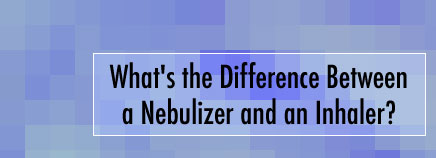
Inhalers and nebulizers are two different devices used to deliver quick-relief medicines (also called rescue or fast-acting medicines) or long-term control medicines (also called controller or maintenance medicines) directly into the lungs.
Inhalers
Inhalers are portable, handheld devices that are available in two types:

Metered dose inhalers (MDI) are the most commonly prescribed. Like mini-aerosol cans, these devices push out a pre-measured spray of medicine. When the person squeezes the inhaler, a measured “puff” of medicine is released. Some MDIs have counters that indicate how many doses remain. If there’s no counter, the number of doses already used should be tracked, so that the inhaler can be replaced on time.
Kids who use a metered dose inhaler also might use a spacer, which attaches to the inhaler and makes it easier to use. A spacer is a kind of holding chamber for the medicine, which eliminates the need to closely coordinate squeezing the inhaler and inhaling the medicine. With an inhaler and spacer, the medicine can be inhaled slowly when the user is ready. So, it’s possible for very young kids and even babies to receive their medications using a metered dose inhaler with a spacer.
Spacers also make inhalers more effective. Sometimes with an MDI, the medicine will reach the back of the throat but not get down into the lower airways. A spacer helps to deliver the medicine into the lower airways, which is where it needs to go to work properly.
Babies and younger kids use a facemask (a plastic cup that covers the mouth and nose) to inhale the medication held in the spacer, whereas older kids can use a mouthpiece. It usually only takes a couple of minutes or less to give medication by metered dose inhaler with a spacer.
Dry powder inhalers deliver medicine in powder form, but they don’t spray out. The user must do more of the work, inhaling the powdered medicine quickly and quite forcefully. At around 5 or 6 years of age, most kids are able to do this.
During an office visit, the doctor may ask your child to demonstrate using the inhaler and offer advice, if needed.
Nebulizers
Nebulizers are electric- or battery-powered machines that turn liquid asthma medicine into a fine mist that’s inhaled into the lungs. The user breathes in the mist through a mouthpiece or facemask. Nebulizers vary in size and shape, but can be a bit bulky and noisy and may need to be plugged in.
A child doesn’t have to “do” anything to receive the medicine except stay in one place and accept the mouthpiece or facemask. It usually takes about 5 or 10 minutes to give medication by nebulizer, and sometimes longer. Nebulizers can be less effective if a child is crying during use, since less medicine will be inhaled.
Practice, Practice
Be sure the doctor shows you how the nebulizer or inhaler works so that you can teach your child how to use it correctly. Improper usage may result in less medicine getting into your child’s lungs. Reviewing the instructions that come with the inhaler and practicing at home can help, too.
If you have any questions about the device or if you’re concerned that your child isn’t getting the proper dose of medication, talk to your doctor.

